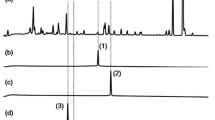Abstract
Entomopathogenic nematodes (EPN) belonging to the families steinernematidae and heterorhabditidae and their symbiotic bacteria Xenorhabdus and Photorhabdus are well-known as biological control agents and are found to produce a wide range of bioactive secondary metabolites. Studies carried out at the Central Tuber Crops Research Institute (CTCRI) on entomopathogenic nematodes resulted in the identification of novel EPN belonging to the family Rhabditidae. This study reports the purification of a high molecular weight antibacterial protein from culture filtrates of a bacterium (Bacillus cereus) symbiotically associated with a novel entomopathogenic nematode Rhabditis (Oscheius) species, maintained at CTCRI laboratory. Fermentation conditions were standardized and optimum antibacterial activity was observed in tryptic soy broth after 48 h incubation at 30 °C. The aqueous extracts yielded antibacterial proteins which were purified by ammonium sulfate precipitation followed by ion exchange chromatography and size exclusion chromatography. Native gel electrophoresis indicated an active protein of molecular mass 220KDa which resolved into a major band of 90 kDa and a minor band of about 40 kDa on SDS-PAGE. The 90 kDa protein showed antibacterial activity and was further analysed by MALDI TOF—MS/MS. The protein was identified as a TQXA (Threonine–glutamine dipeptide) domain containing protein from Bacillus cereus. The protein was found to be active against Bacillus subtilis MTCC2756, Staphylococus aureus MTCC902 and Escherichia coli MTCC 2622 and was thermally stable.










Similar content being viewed by others
References
Abhyankar W, Hossain AH, Djajasaputra A, Permpoonpattana P, Beek AT, Dekker HL, Cutting SM, Brul S, de Koning LJ, de Koster CG (2013) In pursuit of protein targets: proteomic characterization of bacterial spore outer layers. J Proteome Res 12:4507–4521
Akhurst RJ (1982) Antibiotic activity of Xenorhabdias spp., bacteria symbiotically associated with insect pathogenic nematodes of the families Heterorhabditidae and Steinernematidae. J Gen Microbiol 128:3061–3065
Barbercheck ME, Kaya HK (1990) Interaction between Beauveria bassiana and the entomopathogenic nematodes, Steinernema feltiae and Heterorhabditis heliothidis. J Invertebr Pathol 55:225–234
Bowen DJ, Ensign JC (1998) Purification and characterization of a high-molecular-weight insecticidal protein complex produced by the entomopathogenic bacterium Photorhabdusluminescens. Appl Environ Microbiol 64:3029–3035
Chen G, Dunphy GB, Webster JM (1994) Antifungal activity of two Xenorhabdus spp and Photorhabdus uminiscens spp of Heterorhabditis megidis. Biol Control 4:157–162
Collins J, Pijkeren JPV, Svensson L, Claesson MJ, Sturme M, Li Y, Cooney JC, Sinderen DV, Walker AW, Parkhill J, Shannon O, Toole PW (2012) Fibrinogen-binding and platelet aggregation activities of a Lactobacillus salivarius septicaemia isolate are mediated by a novel fibrinogen-binding protein. Mol Microbiol 85:862–877
Deepa I, Mohandas C, Siji JV (2011) Molecular characterization of novel symbiotic bacteria from entomopathogenic nematodes. National seminar on climate change and food security: challenges and opportunities for tuber crops, 22–24 Jan, 399–404
Duax WL, Griffin JF, Langs DA, Smith GD, Grochulski P, Pletnev V, Ivanov V (1996) Molecular structure and mechanisms of action of cyclic and linear ion transport antibiotics. Biopolymers 40:141–155
El-Hag HA, El-Sadawy HA (2008) Xenoprotec: antimicrobial agent derived from Xenorhabdus indic a. Am Eurasian J. Agric Environ Sci 3:568–576
Gaugler R, Kaya HK (1990) Entomopathogenic nematodes in biological control. CRC Press Inc, Boca Raton
Han R, Ehlers RU (1999) Trans-specific nematicidal activity of Photorhabdus luminescens. Nematology 1:687–693
Hancock RE, Chapple DS (1999) Peptide antibiotics. Antimicrob Agents Chemother 43:1317–1323
Hoffman MP, Frodsham AC (1993) Natural enemies of vegetable insect pests. Cornell Cooperative Extension, Cornell University, NewYork
Hu K, Li J, Webster JM (1999) Nematicidal metabolites produced by Photorhabdus luminescens (Enterobacterioaceae), bacterial symbiont of entomopathogenic nematodes. Nematology 1:457–469
Laemmli UK (1970) Cleavage of structural proteins during assembly of the head of bacteriophage T4. Nature 277:680–685
Lowry OH, Rosebrough NJ, Farr AL, Randall RJ (1951) Protein measurement with the Folin phenol reagent. J Biol Chem 193:265–275
Mohandas C, Sheela MS, Mathews S, Naveen Raj DS (2004) Rhabditis (Oscheious) Spp (Nematoda:Rhabditidae) a new pathogenic nematode of crop pests. National sympo.green pesticides for insect pest management 5–6 Feb Abstr.51–52
NCCLS (National Committee on Clinical Laboratory Standards) (2000). Methods for dilution antimicrobial susceptibility tests for bacteria that grow aerobically. Approved standard, 5th ed. NCCLS document M7-A5. NCCLS, Wayne, PA
Ribeiro C, Vignes M, Brehe´lin M (2003) Xenorhabdus nematophila (enterobacteriacea) secretes a cation-selective calcium- independent porin which causes vacuolation of the rough endoplasmic reticulum and cell lysis. J Biol Chem 278:3030–3039
Winnebeck CL, Paterson NG, Young PG, Middleditch MJ, Greenwood DR, Witte G, Baker EN (2014) Structural model for covalent adhesion of the streptococcus pyogenes pilus through a thioester bond. J Biol Chem 289:177–189
Xia ZY, Hui ZA, Ga MR, Can ZY, Feng WS (2008) Purification and antimicrobial activity of antimicrobial protein from brown-spotted grouper. Epinephelus fario Zool Res 29:627–632
Xiao Y, Meng F, Qiu D, Yang X (2012) Two novel antimicrobial peptides purified from the symbiotic bacteria Xenorhabdus budapestensis NMC-10. Peptides 35:253–260
Acknowledgments
The authors are grateful to the Director, Central Tuber Crops Research Institute (CTCRI) for providing facilities and to Life Science Research Board (LSRB) for financial support. K. M. Anju also availed University Junior Research fellowship (JRF) from University of Kerala.
Author information
Authors and Affiliations
Corresponding author
Rights and permissions
About this article
Cite this article
Anju, K.M., Archana, M.M., Mohandas, C. et al. Purification and identification of an antibacterial protein from the symbiotic bacteria associated with novel entomopathogenic nematode, Rhabditis (Oscheius) sp.. World J Microbiol Biotechnol 31, 621–632 (2015). https://doi.org/10.1007/s11274-015-1816-3
Received:
Accepted:
Published:
Issue Date:
DOI: https://doi.org/10.1007/s11274-015-1816-3




